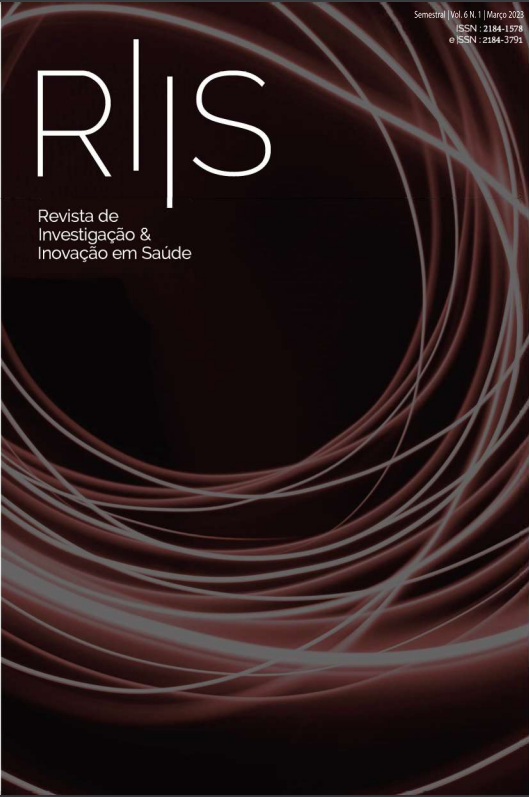A efetividade do decúbito ventral na Acute Respiratory Distress Syndrome: revisão sistemática
DOI:
https://doi.org/10.37914/riis.v6i1.231Palavras-chave:
decúbito ventral, síndrome do desconforto respiratório, revisão sistemáticaResumo
Enquadramento: o decúbito ventral é uma prática clínica baseada na evidência que se encontra bem estabelecida em pacientes com Acute Respiratory Distress Syndrome submetidos a ventilação mecânica invasiva. Porém, existe parca evidência em pacientes não intubados. Face ao aumento da taxa de Acute Respiratory Distress Syndrome, emergiu a necessidade de conhecer a sua eficácia em pacientes não intubados. Objetivo: conhecer a efetividade do decúbito ventral no tratamento da Acute Respiratory Distress Syndrome em adultos não intubados. Metodologia: revisão sistemática fundamentada no manual de Joanna Briggs Institute, com recurso à estratégia PICO. Pesquisa realizada em agosto de 2021, nas plataformas de acesso Web of Science, PubMed e EBSCO Host. Seleção realizada após eliminação de duplicados, leitura do título, de resumos e textos integrais de acordo com o diagrama Preferred Reporting Items for Systematic Reviews and Meta-Analyses. Resultados: identificaram-se 741 resultados, sendo sete os incluídos na revisão. Conclusão: O decúbito ventral precoce revelou-se vantajoso em pacientes não intubados com Acute Respiratory Distress Syndrome ligeira e moderada. É uma intervenção de risco em pacientes não intubados com Acute Respiratory Distress Syndrome grave. Foram identificados indicadores de mortalidade/ sobrevida, fisiológicos/ clínicos, de eventos/ efeitos adversos e indicadores funcionais como preditores de sucesso/ insucesso do decúbito ventral.
Referências
Albert R. K. (2020). Prone Ventilation for Patients with Mild or Moderate Acute Respiratory Distress Syndrome. Annals of the American Thoracic Society, 17(1), 24–29. https://doi.org/10.1513/AnnalsATS.201906-456IP DOI: https://doi.org/10.1513/AnnalsATS.201906-456IP
ARDS Definition Task Force, Ranieri, V. M., Rubenfeld, G. D., Thompson, B. T., Ferguson, N. D., Caldwell, E., Fan, E., Camporota, L., & Slutsky, A. S. (2012). Acute respiratory distress syndrome: the Berlin Definition. JAMA, 307(23), 2526–2533. https://doi.org/10.1001/jama.2012.5669 DOI: https://doi.org/10.1001/jama.2012.5669
Aromataris, E., & Zachary M. (2017). JBI systematic reviews. Joanna Briggs Institute reviewer's manual (2017). https://doi.org/10.46658/JBIMES-20-02 DOI: https://doi.org/10.46658/JBIMES-20-02
Ashbaugh, D. G., Bigelow, D. B., Petty, T. L., & Levine, B. E. (1967). Acute respiratory distress in adults. Lancet 2(7511), 319–323. https://doi.org/10.1016/s0140-6736(67)90168-7 DOI: https://doi.org/10.1016/S0140-6736(67)90168-7
Bamford, P., Bentley, A., Dean, J., Whitmore, D., & Wilson-Baig, N. (2020). ICS guidance for prone positioning of the conscious COVID patient 2020. Intensive care society. https://emcrit.org/wp-content/uploads/2020/04/2020-04-12-Guidance-for-conscious-proning.pdf
Barker, J., Koeckerling, D., & West, R. (2020). A need for prone position CPR guidance for intubated and non-intubated patients during the COVID-19 pandemic. Resuscitation, 151, 135–136. https://doi.org/10.1016/j.resuscitation.2020.04.029 DOI: https://doi.org/10.1016/j.resuscitation.2020.04.029
Bernard, G. R., Artigas, A., Brigham, K. L., Carlet, J., Falke, K., Hudson, L., Lamy, M., Legall, J. R., Morris, A., & Spragg, R. (1994). The American-European Consensus Conference on ARDS. Definitions, mechanisms, relevant outcomes, and clinical trial coordination. American journal of respiratory and critical care medicine,149(3), 818-824. DOI: https://doi.org/10.1164/ajrccm.149.3.7509706
Blez, D., Soulier, A., Bonnet, F., Gayat, E., & Garnier, M. (2020). Monitoring of high-flow nasal cannula for SARS-CoV-2 severe pneumonia: less is more, better look at respiratory rate. Intensive care medicine, 46(11), 2094–2095. https://doi.org/10.1007/s00134-020-06199-9 DOI: https://doi.org/10.1007/s00134-020-06199-9
Bryan A. C. (1974). Conference on the scientific basis of respiratory therapy. Pulmonary physiotherapy in the pediatric age group. Comments of a devil's advocate. The American review of respiratory disease, 110 (2), 143–144. https://doi.org/10.1164/arrd.1974.110.6P2.143
Cherian, S. V., Li, C., Roche, B., Reyes, S. A., Karanth, S., Lal, A. P., Aisenberg, G. M., & Estrada-Y-Martin, R. M. (2021). Predictive factors for success of awake proning in hypoxemic respiratory failure secondary to COVID-19: A retrospective cohort study. Respiratory medicine, 181, 106379. https://doi.org/10.1016/j.rmed.2021.106379 DOI: https://doi.org/10.1016/j.rmed.2021.106379
Dalmedico, M. M., Salas, D., Oliveira, A. M., Baran, F., Meardi, J. T., & Santos, M. C. (2017). Efficacy of prone position in acute respiratory distress syndrome: overview of systematic reviews. Revista da Escola de Enfermagem da USP,51, e03251. https://doi.org/10.1590/S1980-220X2016048803251 DOI: https://doi.org/10.1590/s1980-220x2016048803251
Ding, L., Wang, L., Ma, W., & He, H. (2020). Efficacy and safety of early prone positioning combined with HFNC or NIV in moderate to severe ARDS: a multi-center prospective cohort study. Critical care, 24(1), 28. https://doi.org/10.1186/s13054-020-2738-5 DOI: https://doi.org/10.1186/s13054-020-2738-5
Dodd, S., Clarke, M., Becker, L., Mavergames, C., Fish, R., & Williamson, P. R. (2018). A taxonomy has been developed for outcomes in medical research to help improve knowledge discovery. Journal of clinical epidemiology, 96, 84–92. https://doi.org/10.1016/j.jclinepi.2017.12.020 DOI: https://doi.org/10.1016/j.jclinepi.2017.12.020
Fan, E., Del Sorbo, L., Goligher, E. C., Hodgson, C. L., Munshi, L., Walkey, A. J., Adhikari, N., Amato, M., Branson, R., Brower, R. G., Ferguson, N. D., Gajic, O., Gattinoni, L., Hess, D., Mancebo, J., Meade, M. O., McAuley, D. F., Pesenti, A., Ranieri, V. M., Rubenfeld, G. D., … (2017). An Official American Thoracic Society/European Society of Intensive Care Medicine/Society of Critical Care Medicine Clinical Practice Guideline: Mechanical Ventilation in Adult Patients with Acute Respiratory Distress Syndrome. American journal of respiratory and critical care medicine, 195(9), 1253–1263. https://doi.org/10.1164/rccm.201703-0548ST DOI: https://doi.org/10.1164/rccm.201703-0548ST
Ferguson, N. D., Fan, E., Camporota, L., Antonelli, M., Anzueto, A., Beale, R., Brochard, L., Brower, R., Esteban, A., Gattinoni, L., Rhodes, A., Slutsky, A. S., Vincent, J. L., Rubenfeld, G. D., Thompson, B. T., & Ranieri, V. M. (2012). The Berlin definition of ARDS: an expanded rationale, justification, and supplementary material. Intensive care medicine,38(10), 1573–1582. https://doi.org/10.1007/s00134-012-2682-1 DOI: https://doi.org/10.1007/s00134-012-2682-1
Ferrando, C., Mellado-Artigas, R., Gea, A., Arruti, E., Aldecoa, C., Adalia, R., Ramasco, F., Monedero, P., Maseda, E., Tamayo, G., Hernández-Sanz, M. L., Mercadal, J., Martín-Grande, A., Kacmarek, R. M., Villar, J., Suárez-Sipmann, F., & COVID-19 Spanish ICU Network (2020). Awake prone positioning does not reduce the risk of intubation in COVID-19 treated with high-flow nasal oxygen therapy: a multicenter, adjusted cohort study. Critical care, 24(1), 597. https://doi.org/10.1186/s13054-020-03314-6 DOI: https://doi.org/10.21203/rs.3.rs-53558/v2
Griffiths, M., McAuley, D. F., Perkins, G. D., Barrett, N., Blackwood, B., Boyle, A., Chee, N., Connolly, B., Dark, P., Finney, S., Salam, A., Silversides, J., Tarmey, N., Wise, M. P., & Baudouin, S. V. (2019). Guidelines on the management of acute respiratory distress syndrome. BMJ open respiratory research, 6(1), e000420. https://doi.org/10.1136/bmjresp-2019-000420 DOI: https://doi.org/10.1136/bmjresp-2019-000420
Guerin, C., Baboi, L., & Richard, J. C. (2014). Mechanisms of the effects of prone positioning in acute respiratory distress syndrome. Intensive care medicine, 40(11), 1634–1642. https://doi.org/10.1007/s00134-014-3500-8 DOI: https://doi.org/10.1007/s00134-014-3500-8
Guérin, C., Beuret, P., Constantin, J. M., Bellani, G., Garcia-Olivares, P., Roca, O., Meertens, J. H., Maia, P. A., Becher, T., Peterson, J., Larsson, A., Gurjar, M., Hajjej, Z., Kovari, F., Assiri, A. H., Mainas, E., Hasan, M. S., Morocho-Tutillo, D. R., Baboi, L., Chrétien, J. M., (2018). A prospective international observational prevalence study on prone positioning of ARDS patients: the APRONET (ARDS Prone Position Network) study. Intensive care medicine, 44(1), 22–37. https://doi.org/10.1007/s00134-017-4996-5 DOI: https://doi.org/10.1007/s00134-017-4996-5
Guérin, C., Reignier, J., Richard, J. C., Beuret, P., Gacouin, A., Boulain, T., Mercier, E., Badet, M., Mercat, A., Baudin, O., Clavel, M., Chatellier, D., Jaber, S., Rosselli, S., Mancebo, J., Sirodot, M., Hilbert, G., Bengler, C., Richecoeur, J., Gainnier, M., … PROSEVA Study Group (2013). Prone positioning in severe acute respiratory distress syndrome. The New England journal of medicine, 368(23), 2159–2168. https://doi.org/10.1056/NEJMoa1214103 DOI: https://doi.org/10.1056/NEJMoa1214103
Jahani, S., Hajivand Soleymani, Z., Asadizaker, M., Soltani, F., & Cheraghian, B. (2018). Determination of the Effects of Prone Position on Oxygenation in Patients with Acute Respiratory Failure Under Mechanical Ventilation in ICU. Journal of medicine and life, 11(4), 274–280. https://doi.org/10.25122/jml-2018-0028 DOI: https://doi.org/10.25122/jml-2018-0028
Joanna Briggs Institute. (2013). New JBI levels of evidence: The Joanna Briggs Institute. https://jbi.global/sites/default/files/2019-05/JBI-Levels-of-evidence_2014_0.pdf
Johnson, N. J., Luks, A. M., & Glenny, R. W. (2017). Gas Exchange in the Prone Posture. Respiratory care, 62(8), 1097–1110. https://doi.org/10.4187/respcare.05512 DOI: https://doi.org/10.4187/respcare.05512
Koeckerling, D., Barker, J., Mudalige, N. L., Oyefeso, O., Pan, D., Pareek, M., Thompson, J. P., & Ng, G. A. (2020). Awake prone positioning in COVID-19. Thorax, 75(10), 833–834. https://doi.org/10.1136/thoraxjnl-2020-215133 DOI: https://doi.org/10.1136/thoraxjnl-2020-215133
Moher, D., Liberati, A., Tetzlaff, J., Altman, D. G., & PRISMA Group (2009). Preferred reporting items for systematic reviews and meta-analyses: the PRISMA statement. Annals of internal medicine, 151(4), 264–W64. https://doi.org/10.7326/0003-4819-151-4-200908180-00135 DOI: https://doi.org/10.7326/0003-4819-151-4-200908180-00135
Moola S, Munn Z, Tufanaru C, Aromataris E, Sears K, Sfetcu R, Currie M, Qureshi R, Mattis P, Lisy K, Mu P-F. (2020). Chapter 7: Systematic reviews of etiology and risk. In: Aromataris E, Munn Z (Editors). JBI Manual for Evidence Synthesis. 2020. https://synthesismanual.jbi.global DOI: https://doi.org/10.46658/JBIRM-17-06
Munn, Z., Barker, T. H., Moola, S., Tufanaru, C., Stern, C., McArthur, A., Stephenson, M., & Aromataris, E. (2020). Methodological quality of case series studies: an introduction to the JBI critical appraisal tool. JBI evidence synthesis, 18(10), 2127–2133. https://doi.org/10.11124/JBISRIR-D-19-00099 DOI: https://doi.org/10.11124/JBISRIR-D-19-00099
Paternoster, G., Sartini, C., Pennacchio, E., Lisanti, F., Landoni, G., & Cabrini, L. (2020). Awake pronation with helmet continuous positive airway pressure for COVID-19 acute respiratory distress syndrome patients outside the ICU: A case series. Medicina intensiva, 46(2), 65–71. Advance online publication. https://doi.org/10.1016/j.medin.2020.08.008 DOI: https://doi.org/10.1016/j.medin.2020.08.008
Ramos, S., Gomes, A., Rego, A., Pimenta, P., Pinho, A., & Macedo. A.P., (2021). The effectiveness of the prone position in acute respiratory distress syndrome: systematic review. https://www.crd.york.ac.uk/prospero/display_record.php?ID=CRD42021271481
Simioli, F., Annunziata, A., Langella, G., Martino, M., Musella, S., & Fiorentino, G. (2021). Early Prone Positioning and Non-Invasive Ventilation in a Critical COVID-19 Subset. A Single Centre Experience in Southern Italy. Turkish thoracic journal,22(1), 57–61. https://doi.org/10.5152/TurkThoracJ.2021.20158 DOI: https://doi.org/10.5152/TurkThoracJ.2021.20158
Taboada, M., González, M., Álvarez, A., González, I., García, J., Eiras, M., Vieito, M. D., Naveira, A., Otero, P., Campaña, O., Muniategui, I., Tubio, A., Costa, J., Selas, S., Cariñena, A., Martínez, A., Veiras, S., Aneiros, F., Caruezo, V., Baluja, A., … Alvarez, J. (2021). Effectiveness of Prone Positioning in Nonintubated Intensive Care Unit Patients With Moderate to Severe Acute Respiratory Distress Syndrome by Coronavirus Disease 2019. Anesthesia and analgesia,132(1), 25–30. https://doi.org/10.1213/ANE.0000000000005239 DOI: https://doi.org/10.1213/ANE.0000000000005239
Taccone, P., Pesenti, A., Latini, R., Polli, F., Vagginelli, F., Mietto, C., Caspani, L., Raimondi, F., Bordone, G., Iapichino, G., Mancebo, J., Guérin, C., Ayzac, L., Blanch, L., Fumagalli, R., Tognoni, G., Gattinoni, L., & Prone-Supine II Study Group (2009). Prone positioning in patients with moderate and severe acute respiratory distress syndrome: a randomized controlled trial. JAMA, 302(18), 1977–1984. https://doi.org/10.1001/jama.2009.1614 DOI: https://doi.org/10.1001/jama.2009.1614
Thille, A. W., Esteban, A., Fernández-Segoviano, P., Rodriguez, J. M., Aramburu, J. A., Peñuelas, O., Cortés-Puch, I., Cardinal-Fernández, P., Lorente, J. A., & Frutos-Vivar, F. (2013). Comparison of the Berlin definition for acute respiratory distress syndrome with autopsy. American journal of respiratory and critical care medicine, 187(7), 761–767. https://doi.org/10.1164/rccm.201211-1981OC DOI: https://doi.org/10.1164/rccm.201211-1981OC
Tufanaru C., Munn Z., Aromataris E., Campbell J., Hopp L. (2020). Chapter 3: Systematic reviews of effectiveness. In: Aromataris E, Munn Z., (Editors). JBI Manual for Evidence Synthesis. https://doi.org/10.46658/JBIMES-20-04 DOI: https://doi.org/10.46658/JBIRM-17-03
Wendt, C., Mobus, K., Weiner, D., Eskin, B., & Allegra, J. R. (2021). Prone Positioning of Patients With Coronavirus Disease 2019 Who Are Nonintubated in Hypoxic Respiratory Distress: Single-Site Retrospective Health Records Review. Journal of emergency nursing, 47(2), 279–287.e1. https://doi.org/10.1016/j.jen.2020.12.006 DOI: https://doi.org/10.1016/j.jen.2020.12.006
Zhou, F., Yu, T., Du, R., Fan, G., Liu, Y., Liu, Z., Xiang, J., Wang, Y., Song, B., Gu, X., Guan, L., Wei, Y., Li, H., Wu, X., Xu, J., Tu, S., Zhang, Y., Chen, H., & Cao, B. (2020). Clinical course and risk factors for mortality of adult inpatients with COVID-19 in Wuhan, China: a retrospective cohort study. Lancet 395(10229), 1054–1062. https://doi.org/10.1016/S0140-6736(20)30566-3 DOI: https://doi.org/10.1016/S0140-6736(20)30566-3
Downloads
Publicado
Como Citar
Edição
Secção
Licença
Direitos de Autor (c) 2023 Sílvia Marlene Barradas Ramos, Aramid José Fajardo Gomes, Ana Luisa Rego, Pedro Ezequiel Martins Pimenta, José António Pinho Silva, Silvana Peixoto Martins, Ana Catarina da Costa Maia, Ana Paula Macedo

Este trabalho encontra-se publicado com a Licença Internacional Creative Commons Atribuição 4.0.















